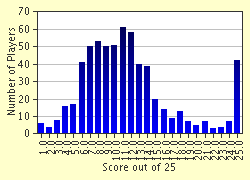Quiz Answer Key and Fun Facts
1. This bird became extinct when the last pair was either clubbed to death or strangled on the island of Eldey, a barren rocky plateau jutting out of the sea off the coast of Iceland. It was June 3, 1844. The birds were likely nesting at the time.
2. This bird is known only from specimens collected in 1827 on Peel Island, off the south coast of Japan.
3. "Incas", the last of this unique bird species, died at the Cincinnati Zoo (Ohio, USA) on February 21, 1918.
4. Which bird of Mauritius, the most famous extinct bird in the world, died out sometime between 1662-1690?
5. This shorebird was once considered among the most common in the Americas. The last confirmed specimen was collected in Barbados, Lesser Antilles in 1963.
6. The extinction of this species occurred in 1983 with the introduction of the brown tree snake (Boiga irregularis) to the island.
7. Considered a pest in the late 1800's, this species had the unfortunate distinction of being deliberately hunted into extinction.
8. In 1830, the plight of this bird species attracted the attention of J. J. Audubon, a world renowned naturalist and ornithologist in whose honor the National Audubon Society is named.
9. Widely thought of as extinct since 1999, this bird may have been sighted in 2004 and 2005 in Arkansas, USA. It was reported in April 2005 by the Cornell Laboratory of Ornithology.
10. Of the four presumed extinct species native to Jamaica, this bird was seen as recently as 1989.
11. Once on the brink of extinction, this flightless species continues to barely survive due mainly to a recovery plan implemented by New Zealand in the 1980's.
12. This species thrived on a small island until 1918, when a ship ran aground off the coast and released rats onto the island's shores.
13. This bird is known only from the single specimen collected on Mauke, Cook Islands by naturalist Andrew Bloxam on August 9, 1825.
14. This species of a small island was a popular delicacy for local convicts and early settlers in the mid to late 18th century, dooming it to extinction.
15. In 1982, Hurricane Iwa killed the last female of this o'o, a type of honeyeater, thus ensuring its extinction.
16. "Martha", the last of a bird species that once numbered in the hundreds of millions, died at the Cincinnati Zoo (Ohio, USA) on September 1, 1914.
17. Last seen in 1932 and thought extinct, this quail was reportedly spotted by Anwaruddin Choudhury (a noted bird watcher) in June 2006.
18. This bird thrived on an isolated volcanic island until an 1876 eruption wiped out the species.
19. According to popular belief, the extermination of this island bird in 1894 was caused by a cat belonging to lighthouse keeper David Lyall.
20. Two portraits of this species discovered in 1774, one of a male and one of a female, hang in the Natural History Museum in London, England. The only two known bird specimens have since been lost.
21. This bird was an unusual type of game bird whose ancestry can be traced back 10 million years.
22. This bird is known only from a single specimen collected in Xinjiang, China in 1929.
23. This bird was eaten into extinction by starving Japanese troops during the final years of World War Two (1939-45).
24. This bird, on the IUCN Red List as "threatened", can be found occupying the wet meadows and shallow marshes across Canada and Northern USA.
25. Which species, now generally agreed not to exist, was named from a single mysterious feather imported into England in 1871?
Source: Author
benniebenbenny
This quiz was reviewed by FunTrivia editor
crisw before going online.
Any errors found in FunTrivia content are routinely corrected through our feedback system.

